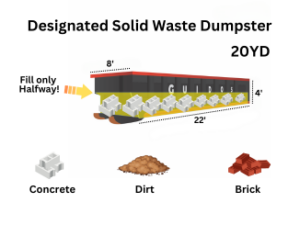How to Properly Load a designated 20-Yard Long Dumpster with Heavy Materials (Concrete, Dirt, or Bricks)
When handling heavy materials like concrete, dirt, stones and bricks it requires the right equipment—and more importantly, the right approach. At Guido’s Services Inc., we provide designated long style 20-yard dumpsters that are perfect for these types of solid waste, but it’s critical to load them correctly to avoid extra fees, safety hazards, and potential delays.
In this guide, we’ll walk you through the proper way to load a designated 20-yard dumpster when disposing of heavy solid waste materials.

Step 1: Know the Dumpster’s Capacity
A 20-yard Long dumpster is spacious enough for most large debris, but when it comes to extremely heavy materials like concrete, dirt, and bricks, filling it completely is not an option. These materials are far denser and heavier than general construction waste or household junk, which means that you can quickly reach the dumpster’s weight limit even if it’s not fully filled.
Key rule: When loading concrete, dirt, or bricks, you should only fill the dumpster halfway! Why? Because a half-full dumpster loaded with these materials can already approach the maximum legal weight for transportation on Massachusetts roads and our equipment handling capacity.
Step 2: Distribute the Load Evenly
Loading a dumpster may seem straightforward, but balance is essential when dealing with heavy materials. Uneven weight distribution can create issues during transportation, making the dumpster difficult to haul and increasing the risk of damage to your property or our equipment.
- Start at the bottom: Place the heaviest and largest pieces of debris (such as concrete slabs or bricks) at the bottom of the dumpster. This will help create a stable base and prevent shifting during transportation.
- Work your way evenly: As you continue loading, be sure to distribute the weight evenly across the dumpster’s floor, avoiding large piles in one area. This ensures that the dumpster remains balanced and safe to move.
Step 3: Don’t Overload the Dumpster
Even if you’re only filling the dumpster halfway, it’s important to avoid overloading it by exceeding the weight limit. Concrete, dirt, and bricks are among the heaviest types of debris, and it’s easy to misjudge how much material you’ve added.
How to Avoid Overloading:
- Fill to the halfway mark: The standard rule for heavy debris is to fill the dumpster no more than halfway. For our 20-yard dumpsters, this means reaching around 2 feet in height for dense materials.
- Avoid high mounds: Ensure the material lies flat, with no towering piles that could make the load unstable. Remember, overfilling or overloading can result in extra charges or, worse, safety concerns.
Step 4: Keep It Clean—Only Solid Waste Allowed
Our 20-yard dumpsters designated for solid waste are for specific materials like concrete, dirt, and bricks. It’s important to avoid mixing other types of debris in the same dumpster. Here’s a quick reminder of what can and can’t go in a solid waste dumpster:
- What’s Allowed: Concrete, dirt, bricks, and other heavy, solid materials from construction or demolition.
- What’s Not Allowed: Household junk, mixed debris, hazardous materials, or general waste. If your project involves other types of debris, contact us to arrange the appropriate dumpster rental.
Step 5: Understand Local Weight Limits
Each state and municipality may have different regulations regarding dumpster weight limits for transportation. In Massachusetts, strict weight restrictions are in place for vehicles hauling heavy debris. Overloading your dumpster can result in significant fines or delays in your project if the load needs to be adjusted.
We recommend reaching out to our team before filling the dumpster to ensure you stay within the allowable limits. We can help assess whether you may need an additional dumpster or provide guidance on how to distribute your load properly.
Step 6: Schedule Pick-up with Us Early
Since solid waste is often dense and heavy, it’s a good idea to schedule your dumpster pickup in advance. This ensures that your full (or half-full!) dumpster is removed promptly so your project can continue without any delays. At Guido’s Services Inc., we’re committed to providing flexible, timely pickups that suit your project schedule.
Why Proper Loading is Essential
Loading a 20-yard dumpster might seem like a simple task, but for materials as dense as concrete and bricks, proper technique is essential. Here’s why:
- Avoid Overage Fees: Exceeding weight limits or filling past the halfway mark can lead to overage fees. By following our guidelines, you can save money and avoid unnecessary penalties.
- Ensure Safe Transport: Our dumpsters and trucks are built for tough jobs, but overloaded or uneven dumpsters can pose safety risks during transport. By distributing your load evenly and sticking to the halfway rule, you keep everyone safe.
- Keep Your Project Moving: Efficient loading means faster removal. Proper loading techniques help us transport your debris quickly, so your project stays on schedule.
Need Help? Guido’s Services Inc. Is Here for You
We understand that handling debris, especially heavy materials, can be a challenge. That’s why our team at Guido’s Services Inc. is here to help you with the dumpster rental process from start to finish. If you’re unsure about how to load your 20-yard dumpster, or if you need guidance on weight limits, just give us a call!
Contact Guido’s Services Inc. today to schedule your dumpster rental or ask us any questions about proper loading techniques. We’re here to ensure your project goes smoothly, safely, and cost-effectively.
At Guido’s Services Inc., we’re dedicated to making your dumpster rental experience as efficient and stress-free as possible. Visit www.guidosservices.com to learn more about our services or to book your next rental.
